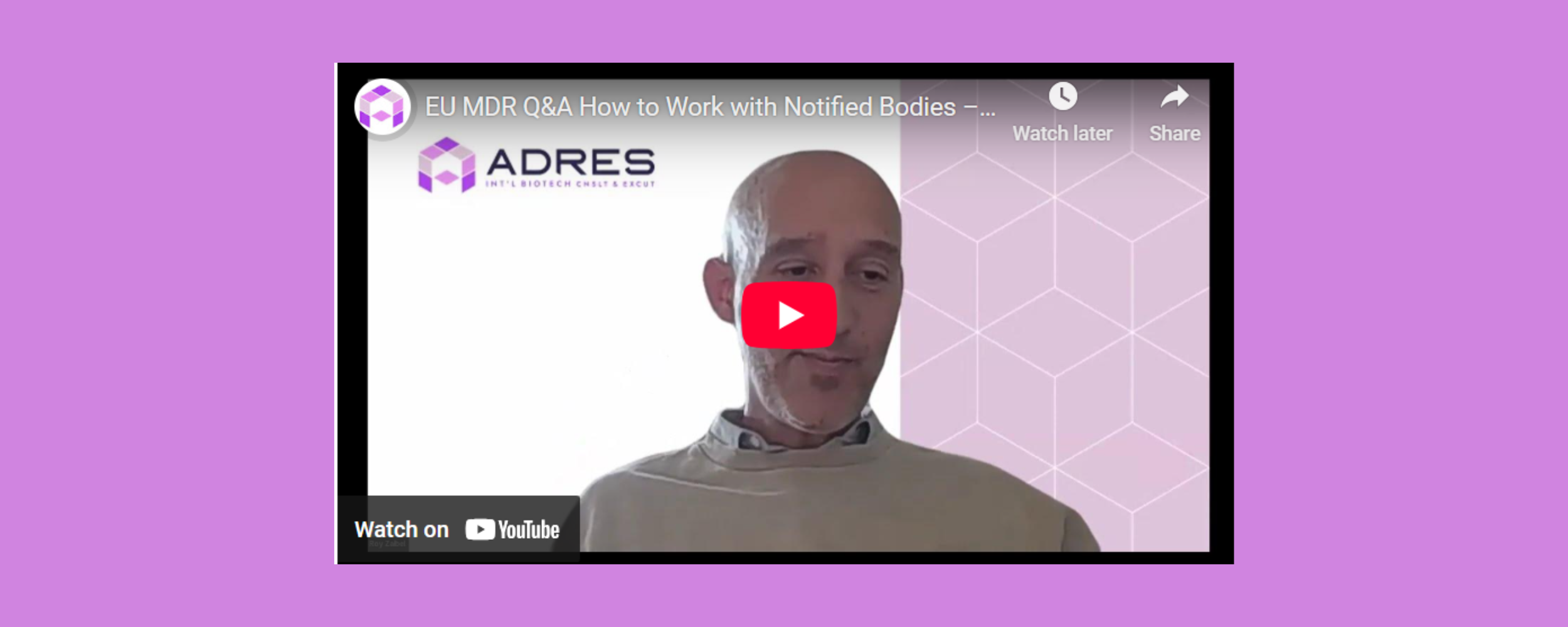EU MDR Q&A | How to Work with Notified Bodies – Szutest × ADRES Webinar
Are NB backlogs, Article 61 clinical evidence or legacy-device deadlines keeping you up at night?
Watch this 60-minute replay as Salih Oğuz Savaş, Rivka Zaibel and Roy Zaibel unpack the 14 hottest MDR questions and share practical, insider tips.
Speakers
- Salih Oğuz Savaş – Deputy General Manager & Head of Notified Body NB 2975, Szutest Konformitätsbewertungsstelle GmbH, Frankfurt am Main, Germany (de.linkedin.com, szutest-germany.de)
- Rivka Zaibel – President & Founder, ADRES Advanced Regulatory Services Ltd.; 35 + years in biopharmaceutics, QA & regulatory strategy (il.linkedin.com)
- Roy Zaibel – Co-CEO, ADRES & Editor of The Bio-Startup Standard (il.linkedin.com)
Don’t risk delays. Watch now and get actionable answers!
What is a Notified Body (NB)?
A Notified Body is an independent organisation, authorised by an EU/EEA competent authority, that assess your device and quality system against the Medical Device Regulation (MDR 2017/745).
Except for a basic, self‑certified Class I device (non‑sterile, non‑measuring, non‑reusable), and non-class III custom made devices, every product needs a positive NB conformity‑assessment decision before you can apply the CE mark plus the NB’s four‑digit ID and place it on the EU, EEA or Northern Irish market.
Can I move my MDR application or certificate to a different NB?
Yes, you can transfer an active MDR application or an issued certificate (Article 58, MDR).
Provide:
- A termination letter from your current NB
- A full application dossier for the new NB
- A transition plan covering every technical‑file element
- Proof that ongoing surveillance will not be interrupted
Acceptance of well‑organised transfers for most devices take two to three months. If your timeline or dossier looks weak, the incoming NB can refuse the project.
Why are more companies requesting NB transfers?
Capacity remains tight: only about forty‑four NBs are designated under the MDR compared with more than eighty under the old Directives. Some have limited product scopes or long backlogs; others have merged or exited. Regulation (EU) 2023/607 extended several deadlines, so many firms now have time to switch.
How long does it take from “hello” to a CE certificate?
With a complete technical file and a mature ISO 13485 QMS, expect:
- Class IIa: about 12 to 18 months
- Class III / implantable: about 15 to 24 months
Main variables: Technical Documentation quality, the speed of your answers to NB questions, reviewer availability, and audit scheduling.
After a successful QMS audit, when will I see my certificate?
You will receive the certificate only when all conformity‑assessment steps have closed (technical‑file review, audit, and final NB decision). The decision phase alone now averages four to ten weeks.
What does Article 61(10) mean for clinical evaluation?
Article 61(10) lets you rely on bench, technical, biocompatibility, and usability data alone when direct clinical evidence would be meaningless (for example, sterilisation devices, patient‑positioning aids. You must still compile a full Clinical Evaluation Report (CER) that justifies this pathway, and your NB must agree. It is not a shortcut for therapeutic devices that could feasibly generate clinical data.
How do I transition a legacy MDD device to the MDR?
Regulation (EU) 2023/607 imposes two pre‑conditions:
[Deadline alert: 26 September 2024] You must:
- Run an MDR‑compliant QMS, and
- Hold a signed NB contract.
If you meet those points:
- Class III and Class IIb implantables may stay on the market until 31 December 2027.
- All other Class IIb, IIa, and I devices may stay until 31 December 2028.
Use that time to close evidence gaps (see MDCG 2020‑6) and keep your post‑market surveillance (PMS) and post‑market clinical follow‑up (PMCF) plans current and linked to the risk file.
Can I submit my technical documentation in stages (“rolling” submission)?
Possibly. During the transition period only, many NBs accept an Incomplete Activities Declaration (MDCG 2022‑11). List every missing test or report with a firm delivery date. Essential documents (CER, risk management, PMS/PMCF plans) cannot be deferred. If you miss a milestone, the NB may pause or terminate the review. After 2028, staged submissions will disappear.
What is a “structured dialogue” with an NB?
A structured dialogue is a formal, written Q&A that clarifies MDR clauses, audit sequencing, or NB scope. It is not consultancy and does not pre‑approve a clinical study; expert panels may be consulted for study plans.
Are aesthetic devices such as HIFU skin‑tightening or laser‑lipo now regulated?
Yes. Listed Annex XVI devices must meet MDR safety and performance rules and forthcoming Common Specifications.
- If you claim a medical benefit, follow the full MDR route.
- For purely aesthetic benefits, NB involvement is still mandatory, but you demonstrate performance rather than therapeutic benefit.
What if I spot missing or incorrect data after submission?
Tell your NB immediately, submit a corrective‑action plan, and redo any tests or clinical work if needed. Hiding problems almost always triggers a major non‑conformity and rejection.
How do NBs judge “state‑of‑the‑art” performance?
They benchmark your device against harmonised standards, MDCG guidance, competitor data, and current clinical practice. A dedicated state‑of‑the‑art section plus clear comparison tables in your CER prevents most extra NB questions.
What MDR reforms are coming?
Draft measures include:
- Statutory NB review timelines
- An e‑certificate module in EUDAMED
- An extended “well‑established technologies” list
- Lighter re‑certification activities
- Clarification on change significant changes
- Clarification on the role of Notified Body for vigilance reporting
All aim to cut red tape while protecting patients.
How can I speed up MDR certification?
- Self‑audit early with MDCG checklists.
- Submit bookmarked PDFs – one requirement per file.
- Answer NB questions within ten business days.
- Maintain a single, live revision log.
- Finalise your PMS and post‑market clinical follow‑up plan before applying, and link both to the risk file.


